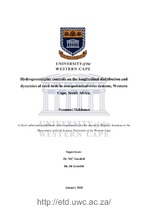| dc.description.abstract | There has been a growing interest in the role of interactions between vegetation and
geomorphology in shaping fluvial environments, from evolutionary to modern-process
timescales. However, much of this work has mainly been done in perennial systems (e.g.
Corenblit et al., 2016; Gibling and Davies, 2012; Gran et al., 2015; Surian et al., 2015). These
interactions have also been to some degree highlighted in dryland rivers (e.g. Grenfell et al.,
2014; Kotschy et al 2008; Tooth and McCarthy, 2007; Tooth et al., 2014; Tooth, 2018). One
of the key ways in which vegetation and geomorphology interact is through the interplay
between channel competence and capacity (Corenblit et al., 2016). This interplay can be
exemplified by reed bed wetland environments. For example, when a dense stand of reeds is
established within a channel, roughness and sediment trapping efficiency are greatly increased,
and this can result in flow diversion, and channel abandonment and infilling (Tooth et al.,
2014). | en_US |

